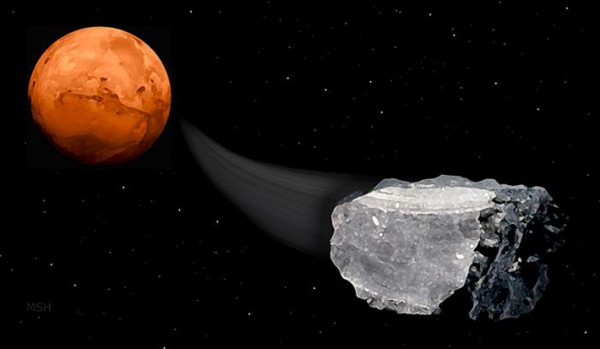
Researchers at Brock University in Canada have found methane in Martian meteorites, lending support to the hypothesis that Mars could be habitable for microbial life, now or in the past. Published on June 16, 2015 in Nature Communications, Nigel Blamey and his team tested six Martian meteorites on Earth and found high levels of methane, carbon dioxide, hydrogen, and nitrogen. They say the methane levels contained in these meteorites – which have made the journey from Mars to Earth, passing through Earth’s atmosphere – could mirror those in the Red Planet’s subsurface crust. Nigel Blamey commented:
The occurrence of methane in Martian rock samples adds strong weight to models whereby any life on Mars is/was likely to be resident in a subsurface habitat, where methane could be a source of energy and carbon for microbial activity.
However, although the discovery of methane in Martian rock is promising in the search for life beyond Earth, it’s not conclusive evidence that biological life exists on Mars. Methane is a simple organic molecule, often produced as a biological waste product. It may also be produced by naturally occurring geologic activity, such as volcanic eruptions or a processes called serpentinization. This process occurs when water is introduced to the minerals in rocks, which causes the changing rocks to release hydrogen gas, which can bind to other gases and form methane.
Spacecraft visiting Mars have detected methane in the planet’s atmosphere, for example, the NASA’s Curiosity rover in late 2014.
To investigate the true nature of the Martian methane, the researchers at Brock used a geochemical technique called a crush-fast scan. That is, researchers crushed samples of Martian igneous rock – meteorites, which impacted Earth from Mars – to release the gases contained within it. Then they analyzed each individual burst of gas.
Because their celestial samples had undergone changes due to heating during their entrance to Earth’s atmosphere, scientists gathered small samples from the interior of the meteorites.
These geological biopsies were approximately one-quarter of a gram in weight. Due to the potential for contamination by earthly sources, researchers first measure the amount of oxygen in each sample. The Martian atmosphere contains approximately 0.146 percent of oxygen compared to the Earth’s 21 percent, so tests on samples with low oxygen levels were better representations of the atmosphere of Mars.
The atmosphere of Mars is thin and dry, and, since Mars doesn’t have a magnetic field, its surface is bombarded by cosmic rays. These conditions don’t bode well for life on the Martian surface. Still, speculation remains that microbial life may exist under the surface of Mars.
Thus the finding of methane in a Martian meteorite adds even more enthusiasm for the European Space Agency’s Exomars Orbiter, expected to survey and land on Mars in January 2016.
Enjoying EarthSky so far? Sign up for our free daily newsletter today!

Bottom line: The discovery of methane in Martian rock is promising in the search for life beyond Earth, but not a conclusive claim that biological life exists on Mars.











